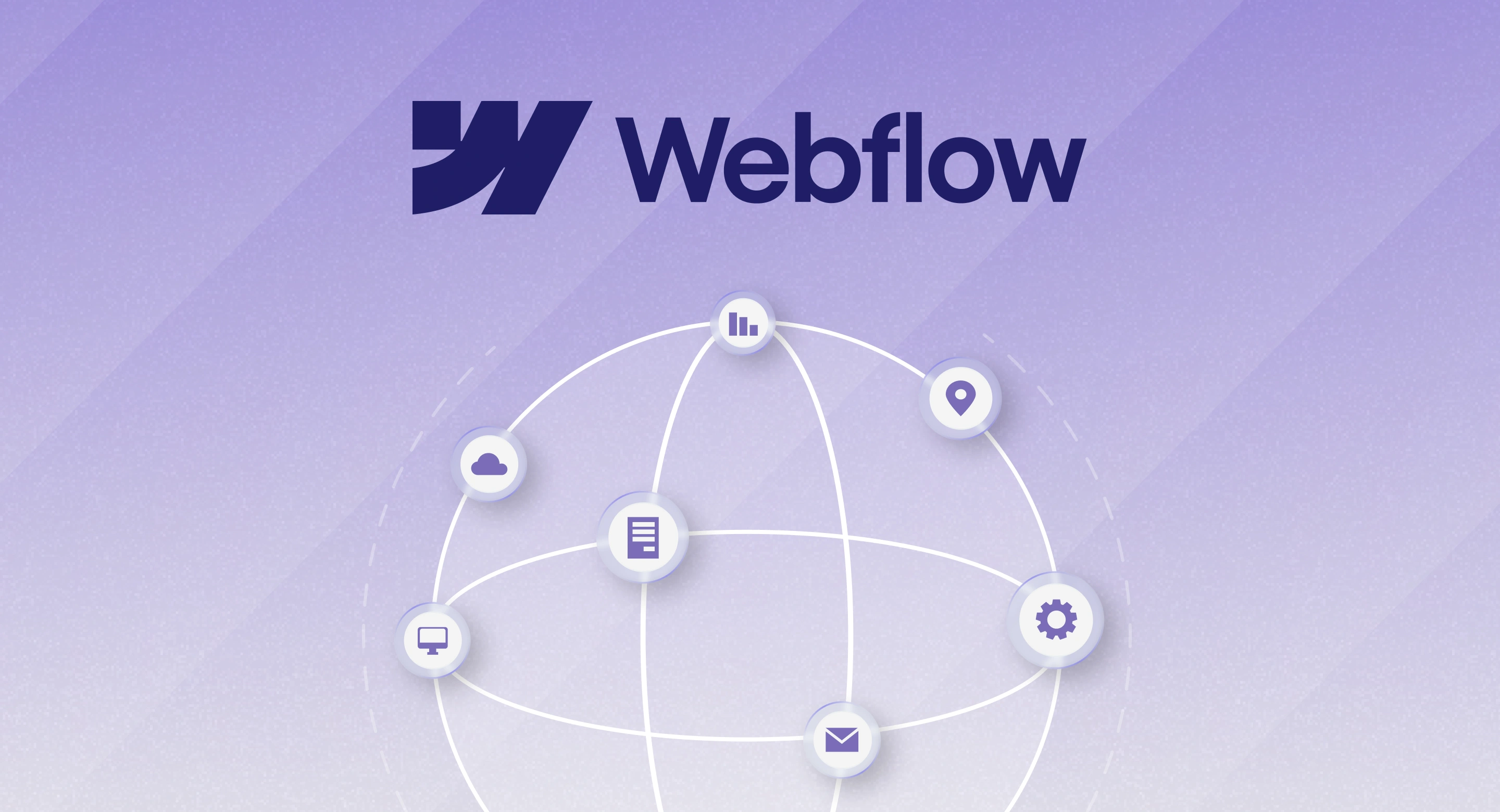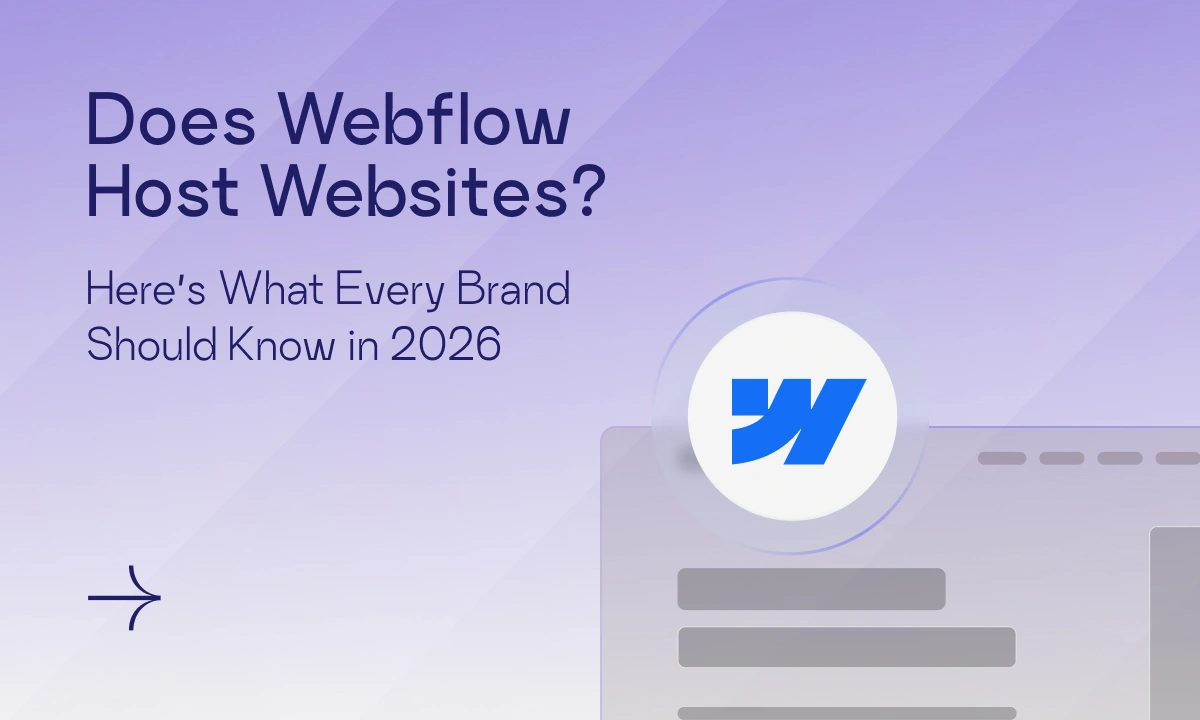Webflow has evolved into a full, end-to-end website platform, and hosting is one of the biggest reasons brands are making the switch. Instead of juggling servers, plugins, and performance issues, teams get fast, secure, globally distributed hosting baked directly into the platform. This guide breaks down exactly how Webflow hosting works in 2026 and why marketing teams rely on it for speed, stability, and scale.
Let’s talk about Webflow. For years, it’s been the darling of the design world; a digital playground where animations glide, custom code shines, and designers finally escape the tyranny of clunky templates. If your brand uses it, chances are your site looks stunning.
But here’s the question marketing teams often forget to ask while admiring all that polish: Does Webflow actually host the website?
In other words, is it just the brilliant architect or also the dependable landlord keeping your digital home running?
In an era where every platform calls itself “all-in-one,” the answer matters. It’s the difference between true scalability and a tangled tech stack that slows your team down.
So we’re cutting through the hype. This post breaks down how Webflow hosting really works in 2026, and why the right setup keeps your brand’s digital home fast, secure, and ready to scale.
What Is Webflow Hosting (and How It Works in 2026)

If you’re new to Webflow, here’s the short version: it’s a full website ecosystem. Webflow brings design, content management, and hosting together in one seamless workspace.
It’s everything your team needs from design to deployment, without switching platforms. No plugins to maintain. No patchwork updates. No separate hosting logins.
Under the hood, Webflow runs on Amazon Web Services (AWS) and delivers content worldwide through the Cloudflare CDN, giving your visitors lightning-fast access no matter where they are.
Every project includes automatic SSL certificates, backups, and version control, all managed behind the scenes so your team never has to think about servers or maintenance.
Why It Matters for Marketing Teams
Webflow hosting gives marketing teams something every campaign needs: momentum. Pages go live faster, updates happen without developer bottlenecks, and brand consistency stays intact across every market.
Teams can publish new content, run experiments, and respond to trends in real time, all within a single platform that supports both creativity and control.
Ready to give your team that creative and technical freedom? Explore our Webflow Development Services to see how we help brands launch faster with fewer bottlenecks.
Webflow vs Shared Hosting Comparison: Which Is Better for Growing Brands?
Choosing a hosting platform is a bit like choosing office space for your brand. You can share a crowded building with thin walls and flickering lights, or you can move into a modern workspace that runs smoothly, stays secure, and never slows you down. The same logic applies online.
Shared hosting looks cost-friendly at first glance, but the trade-offs appear the moment traffic grows or a campaign gains traction. Webflow hosting runs on cloud infrastructure designed for speed, uptime, and hands-off maintenance. It gives marketing teams the stability and performance they need without the constant IT overhead.
Here is how the two options compare:
Shared hosting may keep costs low, but it often limits performance and reliability. Webflow hosting removes those barriers with managed infrastructure, automatic scaling, and enterprise-level uptime. The result is a faster, safer website that supports every campaign you launch.
Insight: The real hosting cost hides in lost momentum. When pages lag, leads slip. Reliable performance keeps your marketing engine running at full speed.
Webflow Hosting Plans 2026 Explained
Webflow pricing can look complicated at first glance, but it’s simply designed to give you options. There’s even a free Starter Site plan for prototyping.
The real hosting tiers live under two main plan types: Workspace Plans and Site Plans. Only one of them includes hosting.
Workspace Plans are for teams that build, edit, and collaborate inside Webflow. Designers, marketers, and developers can all work in one shared dashboard. These plans are perfect for production, but they do not host your live site.
Site Plans are where hosting begins. Once your project is ready for launch, you attach a Site Plan to connect it to Webflow’s managed cloud hosting infrastructure. That is what powers your live domain, complete with CDN integration, SSL security, and 99.99% uptime.
Before choosing a plan, it helps to understand the core hosting features in Webflow that come standard across every tier: automatic backups, version control, high site reliability, and a global delivery network that keeps load times fast worldwide.
Webflow divides Site Plans into two categories: one for standard websites and one for e-commerce. Both share the same secure, high-performance foundation.
Website Hosting Plans (annual billing)
- Basic: ~$14/month. Ideal for small business sites. Custom domain, global CDN, SSL, basic limits.
- CMS: ~$23/month. Supports blogs and content-rich sites with dynamic CMS items and up to three editors.
- Business: ~$39/month. Built for high-traffic brands, fastest CDN tier, up to ten editors, and higher limits
- Enterprise: Built for scaling organizations. Pricing is custom, with added benefits such as an SLA uptime guarantee, SSO, and dedicated support.
E-commerce Hosting Plans
- Standard: ~$29/month. Perfect for growing online stores with secure checkout and product management.
- Plus: ~$74/month. Made for established brands, featuring advanced shipping options and custom branding tools.
- Advanced: ~$212/month. Tailored for large retailers with maximum product limits and full scalability.

How Fast and Scalable Is Webflow Hosting?
Once you’ve chosen the right plan, the next question is obvious: how fast and scalable is it really? Because let’s be honest, beautiful websites don’t convert if they crawl. Performance is where Webflow’s managed hosting truly shines.
In marketing, website speed directly translates into revenue. Every extra second your page takes to load chips away at conversions, credibility, and campaign momentum. Webflow hosting prevents that slowdown by pairing global infrastructure with performance-first architecture.
Built for Speed
According to Webflow’s official data, their infrastructure handles millions of page views each month with server response times under 100 ms, even during peak traffic.
Leveraging its global cloud infrastructure (AWS) and the Cloudflare CDN, Webflow delivers content to 95% of global visitors in under 50 milliseconds. This high-speed edge network is the foundation of your performance.
Independent tests show Webflow sites typically load in ~2 seconds on desktop and under 3 seconds on mobile, thanks to lightweight, semantic code and automated image optimization.
Every Webflow site includes built-in speed features:
- Responsive images generation for every screen size
- WebP optimization and compression that reduce file weight.
- Built-in CDN caching for near-instant repeat visits.
Scales Automatically
Unlike traditional hosting that chokes under pressure, Webflow’s architecture expands elastically during peak traffic. Because your pages are pre-rendered static HTML, CSS, and JavaScript, there’s no live database to crash, meaning your site stays up even when your campaign goes viral.
No manual scaling. No panicked midnight calls to IT.
Proof in Action
- E-commerce brands rely on Webflow for speed and reliability during flash sales or product drops, with PCI-compliant checkout and inventory stability.
- Enterprise clients benefit from SLA-backed uptime guarantees, SOC 2 Type II compliance, and dedicated infrastructure to support multi-region traffic and governance needs.
Reducing load time by 0.1 seconds can increase conversions by up to 8 %, according to Deloitte and Google’s joint research. Speed drives trust, engagement, and measurable ROI.
How Reliable and Secure Is Webflow Hosting?

When your website drives campaigns, lead generation, and reputation, reliability is not optional. Webflow hosting keeps your digital presence live, fast, and secure around the clock, without the late-night tech drama.
Consistent Uptime That Builds Confidence
Reliability is built directly into Webflow's core infrastructure. The platform guarantees an average 99.99% uptime, which is formally backed by a contractual SLA (Service Level Agreement) included in Enterprise Site Plans.
For marketing teams, that means fewer crisis messages and no surprise downtime mid-campaign. Your landing pages stay up when it matters most, and your audience never meets an error page.
Security That Works Quietly in the Background
Protection starts deep in the infrastructure. Every project includes SSL encryption, SOC 2 Type II compliance, and GDPR alignment, all handled automatically. The Cloudflare edge network adds DDoS protection, keeping sites safe during high-traffic peaks or unexpected activity.
Cloudflare Enterprise can be added for real-time monitoring and extra peace of mind for brands that attract heavy traffic during product launches or global campaigns..
Hands-Off Maintenance
Because Webflow is fully managed, there are no plugins to update, patches to install, or server conflicts to resolve. Your site stays stable and secure without developer intervention, so your team can focus on growth, not technical firefighting.
Reliability and security protect more than data. They protect trust. And in a world where attention moves fast, trust is what keeps your brand in the spotlight.
How Hosting Impacts Your SEO & Core Web Vitals
A fast site is not just user-friendly. It is Google-friendly. Hosting quality shapes how search engines see and rank your brand. Google’s Core Web Vitals measure real experience, and your hosting infrastructure plays a major role in all three metrics.
Webflow’s global CDN and clean, semantic codebase help sites meet Google’s recommended Core Web Vitals benchmarks:
- LCP (Largest Contentful Paint): Global CDN delivery helps key content load quickly, often within Google’s 2.5-second guideline.
- FID (First Input Delay): Optimized hosting infrastructure keeps site interactions responsive and smooth
- CLS (Cumulative Layout Shift): Managed asset loading and adaptive design to maintain visual stability across devices.
Together, these signals tell search engines your site is trustworthy, stable, and fast — the trifecta of high-ranking pages.
Webflow automatically handles many technical SEO essentials: it produces clean, crawlable code, manages 301 redirects during redesigns, and generates XML sitemaps to guide search engines efficiently.
Security strengthens this foundation. Every project includes SSL encryption by default, adding another layer of trust for both users and algorithms.
When combined with our ongoing Webflow SEO Services, Webflow hosting creates a foundation that helps brands climb search rankings faster and stay there.
Integrating Webflow with Your Marketing Stack
So, we have established that Webflow is fast, beautiful, and handles the hosting. Still, there’s one thing every marketing team wonders: Does it play well with the stack of MarTech tools your company already runs?
The short answer is yes, and far more elegantly than most legacy systems that claim to do the same. Every marketing director knows the frustration: connecting a CMS to a CRM, only for a single plugin update to break the link and flood your Slack channel with red alerts.
Webflow avoids this entirely by treating integration as a core function, not an optional upgrade.
Instead of relying on patchwork plugins that require constant maintenance, Webflow comes with a mature App Ecosystem and open APIs. For your team, that means:
- Seamless data flow. Webflow connects natively with HubSpot and integrates with tools like Salesforce or Marketo via its API or third-party connectors.
- Headless content flexibility. Through its API, Webflow’s CMS can function in a headless setup, letting teams distribute content to external apps or microsites.
- Zero-friction analytics setup. Tools such as Google Analytics, Tag Manager, VWO, or Optimizely connect directly through site settings. The platform manages the code placement so your operations team can focus on performance, not syntax.
The result is a connected, resilient marketing ecosystem where your technology finally works as intended, without constant developer intervention.
Migrating to Webflow Hosting: What to Expect?
Let’s be honest: the word migration probably brings back memories of late nights, broken links, and frantic Slack threads asking why the homepage suddenly looks like a ransom note. Moving a large, content-heavy website has a reputation for chaos.
The good news? Migrating to Webflow is far less dramatic. Because Webflow is an all-in-one ecosystem, you are not juggling developers, IT vendors, and third-party hosts. The process is structured, predictable, and surprisingly calm.
Here is what it looks like in practice:
1. Audit and Preparation
Before anything moves, the current site is reviewed for structure, speed, and SEO signals. Content models are mapped, metadata preserved, and redirects planned. This ensures the new setup mirrors the existing experience without risking visibility or performance.
2. Content and Design Transfer
The next step is building the new Webflow environment. Your team (or ours) imports existing blogs, pages, and assets using Webflow’s clean CMS structure. Once everything is staged and approved, the new site is connected to Webflow’s managed cloud hosting.
3. The Zero-Downtime Launch
Your current site stays live until the very last second. When everything is tested and ready, the migration is completed by updating your DNS records. It is a clean, surgical handover. No downtime, no broken databases, and no late-night rollbacks.
4. SEO & Redirects
Finally, every valuable link from your old site is redirected to its new home. Webflow’s native redirect management makes this step simple, keeping traffic, backlinks, and search rankings intact.
Think of it as moving into a purpose-built digital home. There is some unpacking, but once you are settled, everything runs faster, cleaner, and without the constant maintenance surprises of your old setup.
The ROI Verdict: Investing in Agility for 2026
The initial question was simple: Does Webflow host websites? The answer? Absolutely yes.

But here’s what really matters for marketing leaders: does Webflow hosting deliver ROI that scales with your growth?
The evidence says it does. Webflow hosting is not a technical expense; it is an operational investment that improves efficiency, reduces costs, and accelerates growth. It replaces maintenance headaches with a predictable, high-performance infrastructure designed for modern marketing.
1. Cost Efficiency
Webflow eliminates the hidden costs of plugins, patching, and server management, reducing the Total Cost of Ownership (TCO).
2. Time Is Revenue
The greatest ROI comes from speed. With design and hosting unified, marketing teams launch faster and operate independently.
3. Conversion Lift
Speed and reliability drive conversion. With cloud hosting, CDN integration, and performance optimized for Core Web Vitals, Webflow provides the foundation for higher conversion rates.
The Final Word:
Choosing Webflow hosting in 2026 means opting for a strategic, growth-focused platform. It is the definitive shift away from the legacy complexity of the past and toward a cohesive digital experience that fuels your team's velocity.
As a Certified Webflow Partner, Creative Corner helps brands turn that promise into performance.
Stop paying the maintenance tax on an aging website. Invest in a platform that truly serves your brand's future.









